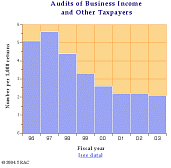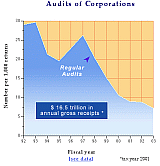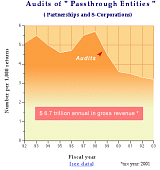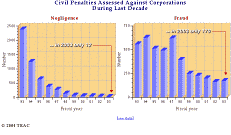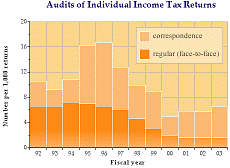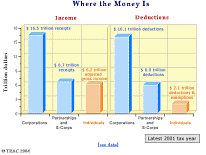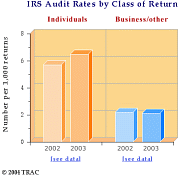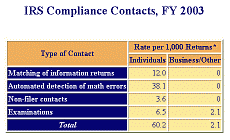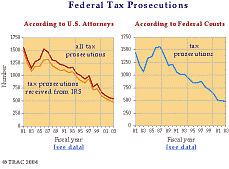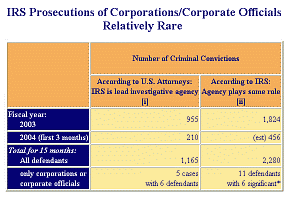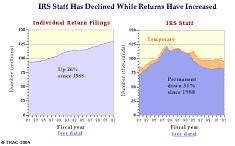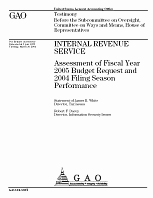![]()
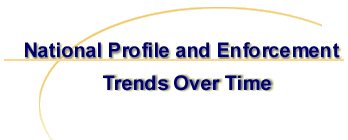
Bark or Bite?
Timely government data show that major IRS programs to enforce the tax laws against businesses and corporations are continuing to slump. The data were obtained and analyzed by the Transactional Records Access Clearinghouse (TRAC). Here are some highlights:
Figure 1. Click for larger image. Audits for business taxpayers are down, 3 audits per 1,000 tax returns five years ago, 2 audits per 1,000 returns in FY 2003. (This rate just one year prior, in FY 2002, was 7% higher.) See Figure 1.
The decline in face-to-face-audits for all corporations (one kind of business organization) was steeper, 15 per 1000 in FY 1999, 7 per 1000 in FY 2003. (This rate just one year prior, in FY 2002, was 21% higher.) See Figure 2.
Figure 2. Click for larger image. For the largest corporations, those with $250 million or more in assets, 347 out of every 1,000 were audited in FY 1999. This compared with 290 out of 1,000 last year. (This rate just one year prior, in FY 2002, was 16% higher.) See table.
The audit rate for what are known as pass-through entities also has continued to decline, 4.5 per 1,000 in 1999, 3.2 per 1,000 in 2003. In a recent year, the returns filed by pass-through entities such as partnerships and S corporations reported gross revenues of $6.7 trillion dollars. While long favored by lawyers and doctors, these entities increasingly are being used by thousands of firms (Enron was a trail blazer) to gain special tax advantages. See Figure 3.
Figure 3. Click for larger image. The number of civil penalties assessed each year against corporations for tax fraud and negligence has always been minuscule, particularly when it is recalled that more than 2.4 million corporations are currently filing tax returns. But, small as the number of these assessments have long been, the counts recently have shrunk even more. From 1999 to 2003, the total number of civil negligence penalties aimed at corporations all over the United States dropped from 62 to 12. In the same period, civil fraud penalties fell from 247 to 170. Although the number of civil fraud penalties increased slightly in 2003, the dollar amount of assessed civil fraud penalties was down 19% last year. See Figure 4.
Figure 4. Click for larger image. The array of declining audit programs that focus on businesses may have special consequences during a period when substantial tax cuts, a less than booming economy and the fiscal demands of homeland security and the wars in Iraq and Afghanistan have together resulted in very large federal deficits.
What the Administration Claims
These and a number of other measures — documented by the agency's own data — indicate that the actual performance of the IRS differs in significant ways from some of the Bush Administration claims when it comes to cracking down on corporate scofflaws.
One such claim was made in a speech at the National Press Club on March 15 by IRS Commissioner Mark W. Everson . Because there was evidence that corporate governance "was coming off the tracks" and that the professional ethics of many tax professionals had declined, Everson said, it was clear that a new get-tough policy was required. "We are correcting our course and re-centering the agency. We are strengthening tax laws in a balanced, responsible fashion."
The first priority, he added, was "to discourage and deter non-compliance, with emphasis on corrosive activity by corporations, high-income individuals and other contributors to the tax gap."
In several of his recent talks, Everson also has emphasized that the overall audit rate for individual taxpayers — as distinct from businesses and corporations — has increased from their all-time lows of a few years ago. However, the claimed increases are entirely the result of agency's growing reliance on computer-generated correspondence audits that by their very nature are comparatively superficial.
Figure 5. Click for larger image.
• In fact, when only face-to-face audits are counted, the audit rate for all individual taxpayers has not changed at all for the last three years — only 1.6 audited for every 1,000 returns filed. See Figure 5. • Focusing just on high income individuals, there was a slight rise in face-to-face audit rates for wage-earners last year– 3.8 per 1,000 returns audited in FY 2002 and 4.0 in FY 2003. However, the audit rate for high income Schedule C (business) filers fell slightly — from 11.4 to 11.0 per 1,000. See table. • And, as already noted, audit rates for business and corporate America are dropping. Commissioner Everson has not been alone in talking up the government's more aggressive stance. Ever since the collapse of Enron and the emergence of a series of other major corporate scandals, President Bush has given speeches repeatedly emphasizing his personal concern about the problem. Speaking to federal prosecutors and investigators at a conference on corporate fraud in September of 2002, for example, the President said the government's ongoing effort to deal with the problem was sending "a clear message to every dishonest corporate leader: you will be exposed and you will be punished." Just a few weeks ago, Mr Bush repeated much the same claim. When his government found out that "some corporate leaders didn't tell the truth," he said, the agencies had reacted "strongly" and the message sent out by his team to the business world had been loud and clear: "we're not going to tolerate dishonesty in the boardrooms of America." The failure to pay lawful taxes, according to many criminal defense lawyers, accountants, and other experts, has always been a major component of white collar crime.
The Challenge
When it comes to tax collection, the vast size of the business sector dramatically underscores the potential payoff should the Administration deliver on its promises to pay more attention to dishonest business practices. IRS data from the latest available year show how the total adjusted gross income for all individual taxpayers was dwarfed by the receipts flowing to U.S. corporations and the various pass-through entities. Here are the numbers. Receipts for taxable corporations in 2001 totaled $16.5 trillion. Receipts for pass-through institutions totaled $6.7 trillion. The combined total of these two categories — $23.2 trillion — was over three times greater than the $6.2 trillion in adjusted gross income reported by individual taxpayers. See Figure 6.
Figure 6. Click for table. Despite the very significant disparity in the size of these three economic sectors, a TRAC analysis of FY 2003 data documents that the IRS — by a three to one margin — concentrates its enforcement efforts on individual taxpayers. For every 1,000 returns filed by a business entity in 2003, there were only 2.1 audits. For every 1,000 returns filed by individual taxpayers, however, 6.5 were audited. This gap in fact is widening. In fiscal year 2002, according to the IRS's last compliance report to Congress, the agency reported 2.2 audits per thousand for businesses versus 5.7 per thousand for individuals. See Figure 7.
Figure 7. Click for larger image. The comparison of how the IRS deals with individual and business taxpayers is even more pronounced when all kinds of "compliance contacts" are considered. These other kinds of contacts include the matching of information returns with tax returns, automated programs to spot math errors and enforcement efforts to identify those who do not file any returns at all. During FY 2003, 60 out of every 1,000 individual taxpayers were contacted under one of these programs. The contact rate for business taxpayers, on the other hand, was only 2 for each 1,000 returns. See Figure 8.
Figure 8. Click for table.
Criminal Enforcement
Because individuals convicted of criminal violations can be sent to prison, such prosecutions represent the government's most serious enforcement sanction when it comes to tax fraud. According to information collected separately by the Justice Department and the federal courts, however, tax prosecutions have also continued their decades long downward slide, now totaling about half what they were a decade ago and one third what they were five years ago. See Figure 9.
Figure 9. Click for larger image. The sharp decline in all kinds of tax prosecutions is disturbing by itself. But information drawn from a new Justice Department system that for the first time ever identifies the tax fraud prosecutions against corporations is even more disturbing. According to this system, in the 15 months from October 1, 2002 to December 31, 2003 only one out of every 200 IRS criminal prosecutions — five cases with six defendants — involved corporations or corporate officials. See Figure 10.
Figure 10. Click for table. The Criminal Division of the IRS, in response to questions from TRAC, argues that the Justice Department data system understates its role in dealing with corporate tax fraud because IRS criminal investigators often provide highly expert support to other agencies.
While this appears to be the case, a brand new reporting system of IRS indicates that the number the number of corporate tax fraud matters in which agency skills were vital remains very small. During the first five months of FY 2004, according to the just-established agency reporting system, the IRS claimed involvement in a total of 11 convictions, only six of which the IRS itself classified as significant. See table.
What ever the number, the IRS indirectly confirmed that business fraud had not been a central concern of the agency in recent years even though in the wake of Enron and other business scandals President Bush established a Presidential Corporate Task Force in 2002. The confirmation came in an agency statement claiming that corporate fraud "had become a priority investigative area of emphasis" for IRS criminal investigators only "in fiscal year 2004."
But the shrinking IRS enforcement numbers do not tell the whole story. Part of what appears to be a growing agency laxness can be attributed to obvious administrative failures. In a March 12 report, for example, the Treasury Department's Inspector General for Tax Administration pointed to what appears to have been a serious flaw. The IRS Criminal Division, the report said, had failed to establish a procedure by which information about the failure of convicted tax criminals to file tax returns or pay their tax liabilities was systematically reported to the courts for action.
Staffing and Budget
An absolutely essential element in delivering on the Administration's promise of tougher tax enforcement — particularly for business organizations and the wealthy — is having a trained staff who have the knowledge and skills required to deal with these often complex cases. And while the number of taxpayers and the size of the economy has ballooned, there is no arguing with the simple fact that IRS resources have shriveled.
Here are the numbers. Since 1988, the IRS's permanent staff has shrunk by 31% while the number of returns filed by individual taxpayers , for example, grew by 26%. See Figure 11. The filings by particular classes of business taxpayers — partnerships, large corporations and S-corporations — have grown even faster.
Figure 11. Click for larger image. The trends for key enforcement personnel are stark (see table):
• In FY 1999, the agency employed 6,399 revenue officers. In FY 2003, there were 5,004. (The number just one year prior, in FY 2002, was 7% greater.) • For the same period, revenue agents went from 13,022 to 11,513. (The number just one year prior, in FY 2002, was 3% greater. • The decline in the agency's criminal investigators was much less, 2,849 to 2,805, although the data show that in the mid-1990s the agency employed more than 3,300 criminal investigators. (The number just one year prior, in FY 2002, was 4% greater.) In a special report issued in early April, the IRS Oversight Board — a Congressionally-authorized panel of independent accountants and tax experts — expressed real concern about the imbalance between resources and demands. The board, noting that this trend shows no signs of abating, said that President Bush's FY 2005 budget request represents "the fourth year in a row in which the Administration has called for IRS staff increases, while not covering pay raises or required expenses."
The practical effect has been that to stay within the budget constraints imposed by the Bush and Clinton administrations the IRS staff continues to decrease.
While not mentioning the current IRS Commissioner Everson by name, the board directly challenged the adequacy of the budget request that he and the Bush Administration continue to defend. The report, dated March 31, said the board believed that the FY 2005 budget "cannot achieve its stated goal" of adding 2,000 new personnel to bolster enforcement efforts while at the same time maintaining "hard-earned improvements in customer service."
On March 30, in its annual report to Congress on the tax agency, the General Accounting Office made the same point as the Oversight Board. In a summary of its report, the GAO said:
(See GAO Report.)
An Administration Proposal
The declining number of IRS employees has had an impact on many different aspects of the government's overall tax enforcement effort. To work on one continuing problem — the actual collection of money owed by delinquent taxpayers — the Bush Administration has been pursuing a plan to hire private debt collectors for dunning purposes. Legislation authorizing the Administration plan has been approved by the Senate Finance Committee.
Under the legislation the Treasury Secretary would be given broad authority to contract with private companies to contact delinquent taxpayers, request the payment of taxes the IRS has determined they owe the government and in some circumstances arrange for the debt to be paid with regular installments. While the contractors are prohibited from performing certain aspects of the job — such as composing the debt collection notices — the proposed law appears to give the Treasury Secretary authority to authorize them to perform "other services" that are not specified.
The legislation also states that up to 25% of all funds collected under the new program can be used to pay "the costs of services provided under such contract." It also establishes that, while the debt collectors would in fact be performing an important and difficult job for the government, the United States "shall not be liable for any act or omission of any person performing services under a qualified tax collection contract."
Report Date: April 12, 2004
